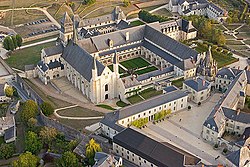Fontevrault prison
| Abbaye Notre-Dame de Fontevraud | |
 |
|
| Monastery information | |
|---|---|
| Full name | Abbey of Our Lady of Fontevraud |
| Other names | Abbey of Fontevrault |
| Order | Order of Fontevrault |
| Established | 1101 |
| Disestablished | 1792 |
| Dedicated to | Our Lady |
| Diocese | Angers |
| People | |
| Founder(s) | Blessed Robert of Arbrissel |
| Important associated figures | Henry II of England, Eleanor of Aquitaine, Richard the Lion-Hearted |
| Architecture | |
| Status | suppressed |
| Functional Status | Cultural Center & Museum |
| Heritage designation | Historic monument of France, World Heritage Site |
| Designated date | 1840 |
| Style | Romanesque, Gothic, Classical |
| Groundbreaking | 1101 |
| Site | |
| Coordinates | 47°10′53″N 0°03′06″E / 47.18139°N 0.05167°ECoordinates: 47°10′53″N 0°03′06″E / 47.18139°N 0.05167°E |
The Royal Abbey of Our Lady of Fontevraud or Fontevrault (in French: abbaye de Fontevraud) was a monastery in the village of Fontevraud-l'Abbaye, near Chinon, in Anjou, France. It was founded in 1101 by the itinerant preacher Robert of Arbrissel. The foundation flourished and became the center of a new monastic Order, the Order of Fontevrault. This order was composed of double monasteries, in which the community consisted of both men and women—in separate quarters of the abbey—all of which were subject to the authority of the Abbess of Fontevraud. The Abbey of Fontevraud itself consisted of four separate communities, all completely managed by the same abbess.
The first permanent structures were built between 1110 and 1119. The area where the Abbey is located was then part of what is sometimes referred to as the Angevin Empire. The King of England, Henry II, his wife, Eleanor of Aquitaine, and son, King Richard the Lionheart were all buried here at the end of the 12th century. It was disestablished as a monastery during the French Revolution.
A UNESCO World Heritage Site, it is situated in the Loire Valley between Chalonnes-sur-Loire and Sully-sur-Loire within the Loire-Anjou-Touraine French regional natural park (Parc naturel régional Loire-Anjou-Touraine).
The complex of monastic buildings served as a prison from 1804 to 1963. Since 1975, it has hosted a cultural centre, the Centre Culturel de l'Ouest.
Robert of Arbrissel had served as the Archpriest of the Diocese of Rennes, carrying out the reformist agenda of its bishop. When the bishop died in 1095, Robert was driven out of the diocese due to the hostility of the local clergy. He then became a hermit in the forest of Craon, where he practiced a life of severe penance, together with a number of other men who went on to found major monastic institutions. His eloquence and asceticism attracted many followers, for whom in 1096 he founded a monastery of canons regular at La Roë, of which he was the first abbot. In that same year Pope Urban II summoned him to Angers and appointed him an apostolic missionary, authorizing him to preach anywhere. His preaching drew large crowds of devoted followers, both men and women, even lepers. As a result, many men wished to embrace the religious life, whom he sent to his abbey. When the canons of that house objected to the influx of candidates of lower social states, he resigned his office and left the community.
...
Wikipedia
